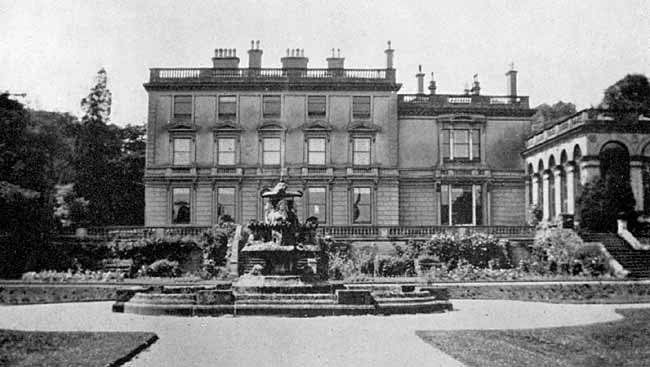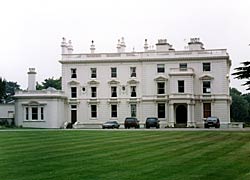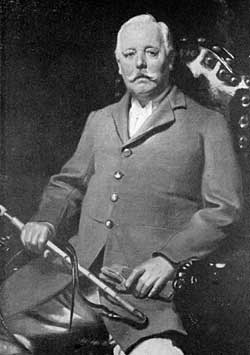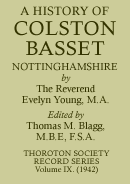< Previous | Contents | Next >
Chapter III.
The manor and its lords (2)

The Hall.
Sir Edward Golding, says Mr. Godfrey, married the daughter and heir of John Wyldman, esq., of Barton, co. Leicester, who survived her husband, but by whom he had no issue. This is hardly correct as to there being no issue. The “John, son of Sir Edward Gelding, Baronett,” who was buried 15th April, 1689, was much more likely their son than the son (said to have become a friar) of the former Sir Edward. There was certainly an only daughter Hellen, who, as daughter of Sir Edward Golding and Dame Winifred his wife was married to Francis Cottington, of Funthill Giffard, co. Wilts., esq., son of Charles Cottington esq., deceased. The marriage settlement was made 5th March, 1708 in it reference is made to several earlier deeds, by the first of which, dated 20th October, 169S, Sir Edward agreed to acknowledge a fine on the manor and rectory of Colston Bassett to the use of Francis Sambrooke, of The Inner Temple, gent., and his brother Jeremy Sambrooke, gent as his trustees. Then follows a list of six mortgages, made between 1701 and 1708 for a total sum of £4900, and there are other debts of Sir Edward’s in all not exceeding £2500, a schedule of which is to be delivered to Francis Cottington within 10 days. By way of jointure Francis settled on Hellen Freemantle Park, co. Hants., which his father had mortgaged for £2000 Sir Edward agreed to pay £3000 on ins daughter’s marriage, viz £1000 to Francis Cottington and £2000 to pay off the last named mortgage. The manor and rectory were granted to trustees to sell what is needful to raise the said £3000 and to pay Sir Edward’s debts, and to settle the remainder on Sir Edward and Dame Winifred for life and then on Francis Cottington and his issue by Hellen.
By indenture dated 14th October 1714, Sir Edward Golding with the concurrence of Francis Cottington, authorised the trustees of the marriage settlement to sell the manor and rectory, in order to pay Sir Edward’s debts; the sale was completed 19th November following. Sir Edward was buried here 8th December, 1715; he died intestate, administration being granted to Dame Winifred Golding, 30th April, 1716. The actual purchaser of the estate was the Earl of Strafford.
Some interesting particulars of the estate are given in the “Strafford Papers” amongst manuscripts preserved in the British Museum, (Add. 22, 252). In July, 1714, a Mr. Ellison forwarded a memorandum apparently for Lord Strafford’s guidance before purchasing the property; from this the following extracts are made:—
Colston Bassett lordship pays yearly to the Queen £160 land-tax at 4s. in the pound.
“It pays to the Vicar of Colston Bassett for tithes of wool, lambs, etc. £27. 10s. per annum by a former composition for. his life.
“It pays to Mr. Chaworth 2s. 6d. per annum and has done so time out of mind for what account I do not know, they call it chief rent.
“All the tenants pay all Parish Duties, they uphold and repair their houses, and they are mostly leased for 11 years, and all the rest of them are willing to lease. They who keep teams bring me amongst them about twenty tun of coals from the Pitt, I there paying for them about 4s. 1d. per tun.
The Fishery of the river Smite is worth £3 per annum. There are no woods either in Colston Bassett or Kinalton except what grows in the hedge-rows which are mostly Ash of which there are a considerable quantity of timber trees and very many young ones, which will in 30 or 40 years be good timber. All is valued to be worth about £300, besides the new fences which I have raised are full of Oak, Ash and Elme.
‘The Impropriation of Colston Bassett belongs to me so no tithe of hay or corn is paid to any body by me or my tenants
The Vicaridge is worth about £80. Its donation is in the Crown.
There belongs to the Mannour a Court Leet and a Court Baron.
Kinalton grounds adjoin to Colston Bassett grounds and are seven in number. They contain 86 ac 8 po their rent is £47 per annum; they pay £8. 12s. land tax, and to the vicar of Kinalton 7s. 4d. all which I pay.
“Colston Bassett is on this side Nottingham 6 miles, from Newark on the Trent 10, from Grantham 10, from Loughborrow 9, from Leicester 13, from Melton Mowbray 7, All which places are great Markett towns and have many great Fairs in them.”
Reference is made to a probable increase in rents as new laid ground comes into use, but the actual rental which accompanied the memorandum is missing.
Sir Thomas Wentworth, who had succeeded a cousin as third Baron Raby, served with distinction in Marlborough’s campaigns, and was repeatedly ambassador to the Courts of Berlin, Vienna and the States General. On 4th September, 1711, in consideration of his eminent services, he was created Viscount Wentworth and Earl of Strafford, with special remainder to his brother Peter Wentworth of Henbury co. Dorset. As it turned out the possession of Colston Bassett followed this special remainder for the Earl by his will dated 22nd June1 1732 and proved 21st December, 1739 left all his freehold estates in trust for his son William, Lord Wentworth and his male heirs, then to his brother Peter Wentworth, and then to William Wentworth, eldest son of Peter. He died 15th. November, 1739, and was succeeded by his son William.
In the Strafford Papers are several rentals of the estate. The earliest of these is here given in full.
“An acct. of Rent Recd. by Mr. Draycott for the use of the Right Honble. the Earl of Stratford out of the Lordship of Colston Bassett in ye County of Nottingham, being one year’s rent due at Ladiday, 1725.
| £ | s. | d. | |
| Wm. Wood | 72 | 0 | 0 |
| Widdow Thompson | 118 | 0 | 0 |
| Wm. Kerkham | 6 | 0 | 0 |
| Mr. (John) Gunn | 131 | 9 | 8 |
| Charles Church | 166 | 10 | 0 |
| Thomas Flintham | 96 | 5 | 0 |
| Thomas Sumnor | 49 | 10 | 0 |
| Hall & Cliffen | 16 | 0 | 0 |
| John Towson (Toulson) | 15 | 18 | 0 |
| James Harvey | 76 | 0 | 0 |
| Widdow Kirkby | 23 | 0 | 0 |
| Wm. Pollard | 3 | 6 | 8 |
| Wm. Geesin | 11 | 2 | 0 |
| Widdow Hopwell | 35 | 11 | 0 |
| Mr. Neadham | 63 | 10 | 0 |
| John Bonser | 8 | 1 | 0 |
| Wm. White | 1 | 8 | 4 |
| Widdow Handly | 11 | 4 | 0 |
| Robt. Mabbot now Church | 18 | 0 | 0 |
| Charles Bosworth | 12 | 0 | 0 |
| Jane Bagerly | 7 | 0 | 0 |
| Stephen Elliot | 11 | 13 | 0 |
| John Cowper | 8 | 0 | 0 |
| John Gibbins | 13 | 12 | 0 |
| Widdow Colishaw | 33 | 15 | 0 |
| Wm. Huffe | 10 | 0 | |
| Widdow Warring | 1 | 11 | 0 |
| Josa. Gregg | 2 | 1 | 4 |
| Thomas Wingfeild | 8 | 0 | 0 |
| James Floid | 3 | 1 | 4 |
| Widdow White | 1 | 5 | 0 |
| Kestor Marriot | 6 | 0 | 8 |
| Cottages | 6 | 0 | |
| The year’s rent at Ladiday 1725 | 1040 | 11 | 8 |
| Arrears due at Ladiday 1724 | 456 | 0 | 1½ |
| Total due | £1496 | 11 | 9½ |
The total rental in 1714 appears to have been about £800. Either the Earl of Strafford had made further purchases of property in the parish, or else there had been an increase in the rents of about 30 per cent.
There are half yearly rentals from Michaelmas, 1731 to Lady Day, 1742, also for Michaelmas, 1762 and for Lady Day, 1765; the payments given being the net receipts after deduction of land tax. Of the four principal tenants in 1725 Church disappears from the list after Lady Day, 1736 and Gunn a year later, while Flintham had already gone before 1731. Apparently their farms were split up into smaller holdings. Elizabeth, widow of John Thompson, husbandman (who had died in 1720), was succeeded in 1734 by their son Thomas, who died unmarried in 1741 and was followed by his brother Joseph, whose name still appears in 1765, paying practically the same rent as his mother paid in 1725. There is one name in the 1725 list which supplies a link with the Present day; Kester (i.e., Christopher) Marriott has descendants of the same name still living in the parish. There is no reference in these lists to any tenant of the Hall; between 1731 and 1742 it seems to have been kept up for the Earl’s occasional use, as the accounts record payments made for the househo1d expenses.
William Wentworth, 2nd Earl of Strafford, was no doubt the next owner of Colston Bassett. He died without issue 10th March, 1791. His uncle Peter Wentworth of Hembury, had died in 1739, and Peter’s eldest son William Wentworth of Hembury, had died in 1775 or 1776. Consequently the earldom descended to Frederick Thomas Wentworth, son of the last named William. But what became of Colston Bassett? The entail made by the first earl appears to have brought this estate, with many, others, to the successor to the title. It certainly did come to him, and from him to his sister; but the reason is not quite clear.
Frederick Thomas Wentworth, 3rd Earl of Strafford, held the title and the estates that went with it for only 8 years. He died without issue 6th August, 1799, thereby large estates, including Colston Bassett, descended to his sister Augusta Ann.
Augusta Ann Hatfield Kaye, wife of John Hatfield, of Wentworth Castle, co. York, esq., to whom she was married 30th May, 1771, made her will 22nd April, 1801. The following extracts are taken from her will. “By an indenture of 1st and 2nd January, 1800, made between me and my said husband of the one part and Henry Martin and Thomas Lowton of the other, I have power by will to appoint, limit and devise (subject to my husband’s life interest) estates that descended to me on the death of my brother Frederick Thomas, Earl of Strafford. It has been agreed that an annuity of £1500 out of the lands in Lincolnshire and Notts. shall be secured to Elizabeth, Countess of Stratford, in lieu of dower; I appoint the Lincoln estate to pay £650 and the Nottinghamshire £850. Subject to this payment I devise all the manor or lordship of Colston Bassett and all my other lands in the county of Nottingham to William, Earl of Fitzwilliam, and Walter Spencer Stanhope in trust to raise and pay to my executors £12,000, and then to Henry Martin, esq., of Lincoln’s Inn and his heirs for ever — Fletcher Norton, Baron of the Exchequer, and Henry Martin, esq., executors.” The will was proved by Henry Martin, 14th May, 1802; and by Fletcher Norton, 22nd June, 1802.
There is a record of a fine in the Court of Common Pleas, Hilary 40 Geo. III (January, 1800): “Henry Martin, esq., and Thomas Lowten, gent., plaintiffs, John Hatfield Kaye, esq., and Augusta Ann Hatfield his wife deforciants, of the manor and rectory of Colston Bassett John and Augusta Ann have acknowledged the above to be the right of him the said Henry as those the said Henry and Thomas had of the gift of John and Augusta Ann. John and Augusta Ann have granted for them and their heirs to warrant the said Henry and Thomas and the heirs of Henry against them and their heirs for ever. And for this acknowledgment the said Henry and Thomas have given to the said John and Augusta Ann £2400 No doubt this was in connection with the indenture quoted in Mrs Kaye’s will and seems to point to a lease of the estate.
With Mrs Kaye’s death the Wentworth interest in Colston Bassett came to an end. It is not likely that any member of the family resided at the hall in fact I have not come across any evidence to show who were the occupants of the hall during this period of about 87 years.
Henry Martin, esq., thus appears to have held the manor of Colston Bassett, first as lessee, than as trustee and finally as owner under the provisions of Mrs. Kaye’s will. He was the second son of Capt. William Martin, R.N., by Arabella, daughter of Admiral William Rowley, of Tending Hall, county of Suffolk, K.B. After some years in the army he took up the profession of the law. He became a K.C. in 1805, was M.P. for Kilsale for 16 years, and was made a master in chancery. He married Maria Elizabeth, elder daughter of Francis Edmunds, of Wetsborough, co. York, esq.; she was co-heiress to her brother Francis Edmunds, who died without issue. Mr. Martin died 18th June, 1839 at the age of 75; his wife died 31st August, 1827. Both were buried at Colston Bassett, and a mural monument to their memory is now in the new Church. The eldest son William Bennet Martin inherited the Worsborough property; Colston Bassett came to the second son Henry Burgess Martin The third son George Bohun Martin, C.B. was a captain in the navy; he died 11th October, 1854, aged 55, at Deptford, and was buried here 18th October; his 6th daughter Mary Anne, who died at East Bridgford, 18th November, 1859, at the age of ten, was also buried here. The fourth son Francis Offley Martin, barrister at law, on 8th October, 1853, purchased the Fearn Closes, in the parishes of Cropwell Bishop and Cropwell Butler, from John Nixon, of Willoughby on the Wolds, farmer, and Elizabeth his wife. Mr. Martin also had a daughter Augusta Anne, no doubt named after Mrs. Kaye in accordance with an insertion (in her, own hand-writing) made in her will, making a bequest to Miss Hannah Crossley for life and then “to the child the wife of Henry Martin beareth provided it is my godchild and baptized Augustus or Augusta.” Mr. Martin had added to the estate by various purchases of land between 1808 and 1838.
Henry Burgess Martin, esq., succeeded to the Colston Bassett estate on his father’s death in 1839. I believe his father had built for him the house now known as “The Hills Farm” and probably he had occupied this. He had several children who were baptised here1and eventually married Anne daughter of John Mackle on 24 December 1804. A few days before his marriage he had sold the property to G.T. Davy esq. After this he went to live at East Bridgeford, where he died 9th June 1882, at the age of 84; his widow died there 7th December 1899, aged 75; both were buried here.
George Thomas Davy, esq. purchased Mr Martin’s property in Colston Bassett 16th December 1864. During the next few years he added various small properties adjoining. On 18th March, 1865 he purchased the Fernfields from Francis Offley Martin of Hampton co. Middlesex, esq.; on 4th February 1871 the remaining part of Gallows Hill, from Mr. Joseph Wells Nixon, of Willoughby-on-the-Wolds; on 23rd April, 1873 a piece of about 7 acres, part of Great and Little Peaslands, from Mr David Fisher. The Fernfields at the time of purchase were settled on his eldest son. Mr. Davy made many changes; the hall itself underwent considerable alteration; the gradient of the hall lane was eased; the whole range of outbuildings, the gardener’s house, lodges, keeper’s house, etc., were erected; a great number of glass-houses, for the perfecting of orchids, were set up; the present school, for the children of Colston Bassett and Owthorpe, was built; the cricket-ground was laid out; a bathing pool was formed; and many of the present woods were planted. Mr. Davy died 13th May, 1874, and was succeeded by his eldest son.

Colston Bassett hall was built c.1704 but was remodelled in the mid-19th century (©A Nicholson, 2003).
George Baynton Davy, esq. made further additions to the property. On 17th May, 1876, he purchased the Colston Bassett farm from Clarence Pigou, esq.; this is the estate which Francis Hacker had purchased from the Goldings; the descent of it will form the subject of another chapter. On 2nd November, 1876, the Stroom and Langar plantations were purchased from John William Miles and others. On 24th December, 1877, Mr. Davy sold the manor and rectory of Colston Bassett, with about 1599 acres of land (including some outlying parts in Kinoulton and Cropwell) to R M. Knowles, of Bosworth Park, esq. That part of the parish known as “the Hills” was not included in this sale; Colston Hills farm was sold subsequently and now belongs to Mr. Thomas Barlow; that part known as Penhill belongs to John James, esq., of Cotgrave Place; the three farms, known in 1877 as The Hills Farm, The Home Farm, and Rose’s Farm, on Mr. Davy’s death in 1907, descended to his son Major G. A. C. Davy of Spean Lodge, Scotland, who still owns them.

Robert Millington Knowles. (Squire from 1877 to 1924). Founder of the Church of St. John. (From the portrait by F.O. Salisbury).
Robert Millington Knowles, esq., eldest son of James Knowles, of Eagly Bank, Bolton, esq., was lord of the manor from 1877 until his death. In 1892 he erected the new church of St. John the Divine in the centre of the village in memory of his eldest son John Haslam Knowles, who died 13th August, 1890, and of his wife Alice Catherine, daughter of Lord Crawshaw, who died 13th March, 1892. This church was consecrated 2nd August, 1892. Mr. Knowles younger son, Alfred Millington Knowles, Lieutenant South Notts. Imperial Yeomanry, was killed in the South African war, 9th August, 1900.
In 1914, Mr. Knowles transferred to the Ecclesiastical Commissioners £1,000 London and North Western Railway 4 per cent Preference Stock, for the augmentation of the vicarage; this was supplemented by an equivalent grant from the Commissioners.
Mr. Knowles died 28th November, 1924, at the age of 81, and was buried on 3rd December in the private burial ground adjoining the New Church.
The manor and rectory, with the Colston Bassett estate, he had settled on his daughter Lady Le Marchant and her issue.
Dame Evelyn Brooks Le Marchant, wife of Brigadier-General Sir Edward Thomas Le Marchant, 4th baronet is now lady of the manor. Sir Edward served as High Sheriff for Nottinghamshire in 1930.
< Previous | Contents | Next >
1. That is natural, or illegitimate, children. From 1844 to 1862 the registers record the baptisms of nine illegitimate children to Ann Mackley, single woman. H B Martin’s son married about 1800 Elizabeth dau of Henry Blagg deceased of Scarrington. T M B
